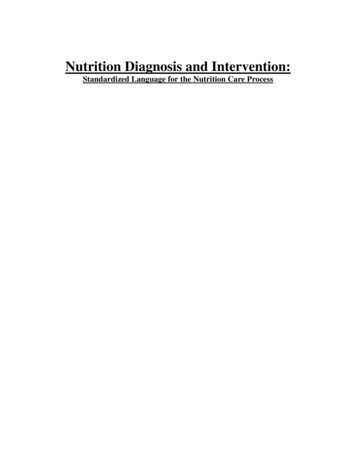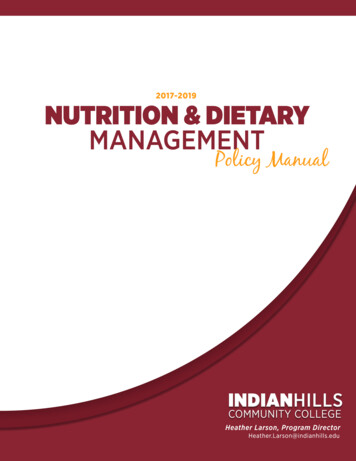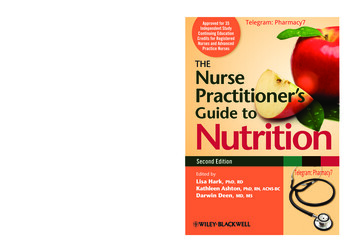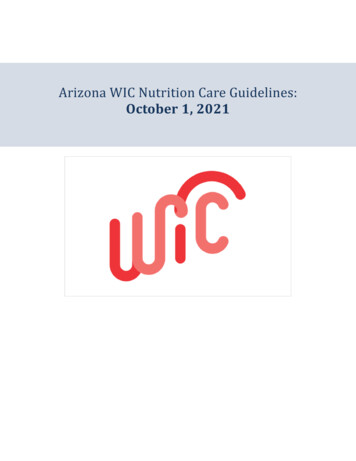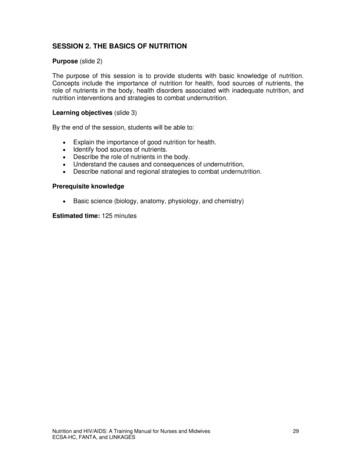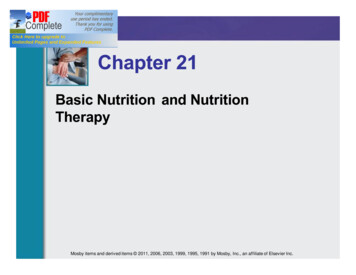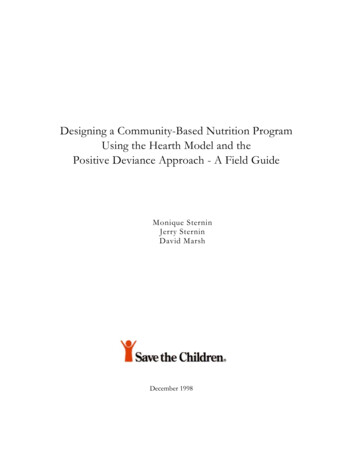
Transcription
Designing a Community-Based Nutrition ProgramUsing the Hearth Model and thePositive Deviance Approach - A Field GuideMonique SterninJerry SterninDavid MarshDecember 1998
This publication was made possible through support provided byThe Partnership for Child Health Care, Inc./BASICS with financing from theUS Agency for International Development, under the terms of Contract No. HRN-C-00-93-00031.The opinions expressed herein are those of the authors and do not necessarily reflectthe views of the US Agency for International Development or the BASICS project. 1998, Save the Children Federation, Inc. All rights reserved.
PREFACEIt is hard to describe the sense of relief and completion I have with the publication of this manual.From 1987-92 I headed a five country study of Positive Deviance in Nutrition. It was the mostexpensive piece of nutrition research that UNICEF ever centrally funded. We turned out fourbooks, a couple dozen journal articles and book chapters, six Ph.Ds. and countless reports.But we never produced the practical field guide which was a major goal of the research. Thispreface explains why by answering obvious questions.What is positive deviance?Positive deviance in nutrition describes young children who grow and develop adequately in poorfamilies and communities, where a high number children are malnourished and frequently ill.They are positive deviant children, and they live in positive deviant families. These familieshave developed culturally appropriate positive deviant practices that enable them to succeed innourishing and caring for their children in spite of poverty and an often high risk environment.These families are uniquely able to provide solutions to malnutrition to other poor families in theircommunities.The concept of learning from positive deviant families crept into the literature early in the international nutrition movement, in the mid-1960s, with calls to pay a great deal more attention to thoseindividuals who are apparently healthy while consuming diets which seem to us to be restricted(Mark Hegsted, 1967), "to study successful mothers" (Joe Wray, 1972), and to identify villagewomen who can cope and manage to rear healthy and active children (Peter Greaves, 1979)applying "maternal technology" (Leonardo Mata, 1980). By 1982, Maria Alvarez had publisheda half dozen studies from poor neighborhoods in Chile on mother-child interactions and homeenvironments related to good nutrition of infants. I believe Gretchen Berggren first came up withthe term "Positive Deviance" in the mid-1980's.Our first book, Positive Deviance in Child Nutrition (Zeitlin, Mansour and Ghassemi, 1990),reviewed more than 180 studies of caring behaviors and social and cultural networks that protectthe nutritional status of poor children and mothers. In the following years the various teams on theproject (Aina, Agiobu-Kemmer, Ahmed, Annunziata, Armstrong, Babatunde, Beiser, Bonilla, Brown,Chomitz, Colletta, Ebam, Engle, Garman, Gershoff, Ghassemi, Guldan, Klein, Kramer,Lamontagne, Mansour, Megawangi, Morales, Peterson, Rogers, Satoto, Seireg, Setiloane,Sockalingam, Weld) published more of the same, showing that women's education, a happymood, and most measures of loving, attentive and patient parenting are linked to good nutrition.Positive deviant children tended to live in cohesive, supportive and well-spaced families. Thesefamilies tended to live in supportive communities with good social services.Positive deviant infants are breast fed. The diets of older positive deviants are richer in animalfoods, such as milk, fish or meat, in fruit and vegetables, and in day-to-day variety than the dietsof malnourished children. Their food, water, and play environments are cleaner and safer. Theirhealth care is better.With such numbingly obvious findings, why did you fail to produce a simple manual?In technical terms, the findings were significant, but the effect sizes were small. AcademicDesigning a Community-Based Nutrition Program Using the Hearth Model and the Positive Deviance Approach3
colleagues were suspicious of "soft" measures of attitudes and behavior. The ways in whichdifferent cultures express attentiveness, cohesiveness, good diets, and so on are different. In thequest for scientific respectability, we relied on sample sizes and analysis methods that were toobig and complicated to package in a field manual.It wasn't always obvious. Positive deviance is one positive layer in a stack of negative adaptationsto poverty and food insecurity. Other adaptations include high death and malnutrition rates.Population "fatigue" diminishes survival to the number of people the food supply can support.Malnutrition "adapts" children into small adults who survive on less food. Negative care allowsunaffordable children to die without blaming their parents. Subsistence agriculture depends onchild labor. Negative feeding and care practices entwined with adaptations of this nature are theprimary targets of nutrition education and growth-monitoring in developing countries.Positive deviance is the evolutionary vitality at the top of the stack - the spark of flame thatflickers into good growth and health, on top of the cinders, a backdrop of practices that damperthe fire so it doesn't go out. This complicated overlay does reduce statistical effect size. It doesmean that researchers don't always find good practices that can simply be taught to the wholecommunity.If a behavior is adaptive because it helps children to survive in spite of conditions that increasemortality, the first need may be to change those conditions. After the change, behaviors thatprotected children may hold them back. For example, constant carrying on the mother's backprotects undernourished children in unsanitary, unsafe environments. But it slows the development of well nourished children in safe clean environments.Then, if it's hard to find positive deviance, how does this simple Manual come up with theanswers? And, is it true that the Positive Deviance Investigation in the Manual visits a totalsample size of only six families?Yes, it's true and cleverly done.First, six is about as many households as a village team can analyze comfortably and discussmeaningfully.Second, the manual uses a positive deviance approach to design a community-based "Hearth"model. But this doesn't depend on positive deviance practices alone. It is based on decades ofexperience in rehabilitating children and educating their mothers using scientifically valid, fieldtested methods.Third, the guide validates the six family investigation with a qualitative assessment of positive andnegative deviance factors conducted by a panel of local experts. This assessment is based on theresults of a literature review, a situation analysis, a nutrition survey, a series of focus groups, and acommunity analysis of the causes of malnutrition. Where results from the six families differ fromthe expert assessment, the team finds out why and modifies the results accordingly.Fourth, the positive deviance approach mobilizes the community. The search for and discovery ofpositive deviance is a dramatic device that leads the community back to the source of its inherentwisdom and evolutionary vitality, and restores to the community the power of taking control of itsnutrition problems.Designing a Community-Based Nutrition Program Using the Hearth Model and the Positive Deviance Approach4
As Jerry Sternin put it, the positive deviance approach is "evolution times two." It takes theevolving edge of good nutritional change, not just static practices, but good change. Instead ofwaiting a generation for the fit to survive, it applies this evolutionary advance immediately, in amanner that speeds the capacity of the population to move forward.Marian F. Zeitlin,CoDirector, the Yoff EcoCommunity ProgramCentre de Ressource pour I'Emergence Sociale Participative(CRESP) Yoff-Dakar, SenegalVisiting Professor, The Tufts University School of Nutrition Science and PolicyDecember 1998Designing a Community-Based Nutrition Program Using the Hearth Model and the Positive Deviance Approach5
FOREWORDThe use of the positive deviance approach has enabled communities in Vietnam and elsewhereto take responsibility for sustainably rehabilitating tens of thousands of seriously malnourished children. Equally significant, the approach has changed the conventional wisdom in communitiesregarding feeding, caring, and health-seeking behavior, thus benefitting generations of childrento come.This field guide is to a large degree the work of Monique Sternin, who pioneered the positivedeviance approach to nutrition in Vietnam over a six-year period. She has spent the past year writing and testing the guide in Mozambique, Egypt, Nepal, Bhutan and Cambodia with the hope ofmaking the approach accessible to those concerned with the problem of malnutrition in othercountries throughout the world.Obviously, knowledge is never complete, and this manual, perhaps more than others, is a "work inprogress." Nonetheless, we feel that enough experience has accrued to justify broader application,even as we study and refine the model in various contexts. There is only one "Monique," so themanual is a strategy to bring her and other's insights to scale. We eagerly await your reactions,reflections, and experience in programming and in research as we move forward together.David R. Marsh, MD, MPHSenior Child Survival Specialist/EpidemiologistHealth, Population and Nutrition UnitInternational ProgramsSave the Children54 Wilton RoadWestport, CT 06880Designing a Community-Based Nutrition Program Using the Hearth Model and the Positive Deviance Approach6
TABLE OF CONTENTS Acknowledgments Glossary Introduction: Purpose of the Field Guide How to Use the ManualPart I9101112Overview Of The Hearth Nutrition Model Positive Deviance as the Cornerstone of the Nutrition Program Positive Deviance Approach in Nutrition The Hearth Nutrition Program's Goals Based on thePositive Deviance Approach Components of a Hearth Nutrition Program Characteristics of a Hearth Nutrition Program Conceptual Framework for Designing a Hearth ProgramPart II14141519Assessing The Feasibility O f Piloting a Hearth Program Assessing the Prevalence of Malnutrition Availability of Local Food Availability of Mothers as Potential Volunteers in the Community Presence of Committed Leadership in the CommunityPart III131320212122Preliminary Steps: Getting Started Step 1: Assessing Community Organization Resourceswith Local Partner Step 2: Identifying Community Health Resourceswith Local Partner Step 3: Helping the Community Select Mothers toBecome Volunteers Step 4: Selecting a Local Nutrition Resource Panel23232526Part IVConducting A Situation Analysis Of Malnutrition WithThe Community Step 1: Reviewing the Health Situation of Young Children withLocal Health Staff Step 2: Carrying Out a Nutrition Baseline Survey of Young Children Step 3: Identifying Current Feeding, Caring and Health SeekingPractices in the Community Step 4: Assessing the Nutrition Situation of Young ChildrenWith the Community27272930Part V Conducting The Positive Deviance Inquiry Background Information and Definitions Process of a Positive Deviance Inquiry Outline of the Positive Deviance Inquiry The Spirit of the Positive Deviance Inquiry Selecting the PDI Team Training of the PDI Team in Conducting the PDI333334343535Designing a Community-Based Nutrition Program Using the Hearth Model and the Positive Deviance Approach7
Household Observations and Guided Interviews Steps for Conducting a Positive Deviance Inquiry Step 1: Planning the PDI With the Community Step 2: Conducting PDI Home Visits Step 3: Selecting and Documenting Key SuccessfulPractices from PDI Findings Potential PDI Pitfalls and Solutions Step 4: Provide Information on PDI Findings to the CommunityPart VI424548Designing A Hearth Nutrition Program With PDI Nutrition Education and Rehabilitation Sessions NERS Participants Identifying NERS Centers with the Help of Volunteers Setting a NERS Schedule Deciding on the NERS Daily Sessions Schedule Creating NERS Menus Incorporating the PD Foods Developing NERS Education Components Developing Strategies to Promote Behavior ChangePart VII363737414949494950505153Other Hearth Nutrition Program Components Growth Monitoring and Promotion Vital Events Community Management Monitoring and Evaluation Deworming Vitamin A Distribution Maternal and Child HealthPart VIII56585960626263Collaboration with District Health Personnel Advantages Disadvantages6565Appendices A. B. C. D. E-1. E-2. F. G-1. G-2. H. I. J. K.Regional Profiles of Positive Deviant Feeding PracticesCharacteristics of TrainingQuestion Guide for Focus Group Discussion on MalnutritionSituation Analysis Results (Nepal)Examples of Good Feeding, Caring, Care-Seeking BehaviorsExamples of Poor Feeding, Caring, Care-Seeking BehaviorsStandard Curriculum for Training of TrainersObservation Check-list During a PDIPDI Observation Recording FormQuestion Guide for Caretaker Interview duringPositive Deviant InquiryCase Study Narrative (Mozambique)NERS CurriculumQualitative Hearth Program Impact (Nepal)Recommended Reading6669707172737477777981828485Designing a Community-Based Nutrition Program Using the Hearth Model and the Positive Deviance Approach8
ACKNOWLEDGEMENTSTo begin at the beginning, this field guide would never have come to pass if it were not for thepeople in the field who took the concept of Positive Deviance, gave it life and form, and translatedit into action.To the "Positive Deviants" in the villages, who taught us what no expert ever could: how it reallycan be done. We thank you and salute your wisdom!The positive deviance approach to the hearth model is the result of the hard work of a dedicatedand committed cadre of grass-roots development workers who sweated in the tropical sun; soakedin torrential downpours; itched with mosquito and fly bites; ached from carrying scales, pots andpans; dozed after meetings with villagers long into the night; grinned from ear to ear when growthmonitoring results showed continuing decreases in malnutrition; and cried when a third degreemalnourished child could not be saved. To you all, the PD pioneers in Vietnam (Hien, Tuan andLang) and at the Schweitzer Hospital in Haiti, first and foremost, our deepest gratitude.Next, to those of you who later took the model, changed it, improved it, made it your own andprovided valuable feedback for the Field Guide: Save the Children Japan (particularly AnirudraSharma) and Save the Children Norway, both in Nepal; AFRICARE in Tanzania; Save the ChildrenUS in Mozambique, Egypt, Nepal and Bhutan; and CARE in Cambodia, many thanks.For those of you who read the earlier drafts of the guide book, provided sound counsel and feedback and attended the round-table in Washington (Liane Adams, Leslie Archer, Kirk Dearden,Victoria Graham, Don Graybill, Marcia Griffiths, Marguerite Joseph, Charles Llewellyn; David Oot,Ellen Piwoz, Victoria Quinn, Donna Sillin, Dirk Schroeder, and Eric Swedberg), our debt of gratitudefor your role in the evolution of the final product. Thanks too to Tamer Kirolos who helped format thebook.To Bart Burkhalter and the BASICS Project, without whose support, moral as well as financial, thefield guide would not have been possible, our sincere thanks, To co-author and friend, DavidMarsh who shepherded, prodded, encouraged and was attending mid-wife at the delivery, ourheartfelt appreciation and gratitude.And finally, a special thanks to Marian Zeitlin whose pioneer work served as the catalyst for thePositive Deviance-Hearth-Nutrition model, and to Gretchen Berggren, who with her husbandWarren, created the Haiti Hearth model, introduced us to the concept, and provided wise counseland support in Vietnam during the early days of our nutrition forays, a great debt of gratitude.Monique Stemin,MA Cairo, 1998Jerry Stemin, MAField Office Director,Egypt Cairo, 1998Designing a Community-Based Nutrition Program Using the Hearth Model and the Positive Deviance Approach9
PNERSNGOPDPDIPEMRBSCJSC/USTBATOTVHCCommunity-based Organization (Egypt)Community Development Association (Nepal)District health servicesExpanded Programme for ImmunizationGrowth Monitoring and PromotionHealth VolunteersIntgrated Management of Childhood IllnessInternational Non-Governmental OrganizationKnowledge Attitude PracticesLow Birth WeightNegative DeviantMaternal and Child HealthMinistry of HealthNutrition Education and Rehabilitation ProgramNutrition Education and Rehabilitation SessionNon-Government OrganizationPositive DeviantPositive Deviance InquiryProtein Energy MalnutritionRedd Barna (Save the Children, Norway)Save the Children, JapanSave the Children, USATraditional Birth AttendantTraining of TrainersVillage Health CommitteeDesigning a Community-Based Nutrition Program Using the Hearth Model and the Positive Deviance Approach10
INTRODUCTIONPurpose Of The Hearth Field GuideFor Whom?This guide is intended for trainers, program officers and managers from NGOs and INGOs or MOHdistrict teams or other organizations working at the grass-roots level, in partnership with thecommunity or through community-based organizations. It has been developed to assist you indesigning a community-based Nutrition Education and Rehabilitation Program in collaboration withthe communities you serve.What?More specifically this guide will help you to: Assess the feasibility of the nutrition program in the proposed context Conduct a Situation Analysis of malnutrition with the community Carry out a Positive Deviance Inquiry with the community Design a community-based Nutrition Program using Positive DevianceInquiry findingsWhy?Malnutrition is the result of many interrelated factors such as poverty, insufficient household foodsecurity, inadequate health services, poor maternal and child care practices, and inadequatewater and sanitation. For communities with a high prevalence of malnutrition, it may take years oreven decades before all of these factors can be addressed. Because today's malnourished children cannot wait, grass-roots development workers need to address their plight today in collaboration with the community.The Hearth Nutrition Model based on the Positive Deviance approach provides encouraginganswers to this question.How?Based on the Positive Deviance approach, communities and their development partners havebeen able to sustainably reduce malnutrition among their young children through a NutritionEducation and Rehabilitation Program in Haiti, Vietnam and Nepal. Similar programs are currentlybeing implemented in Bangladesh, and Mozambique. Moreover, nutritional researchers havefound "positive deviant profiles" in every region (Appendix A).Example: In Vietnam, the Hearth Nutrition Program has achieved a reduction of 2nd and3rd degree malnutrition by 80% among tens of thousands of malnourished children under3 years of age. Moreover the caretakers were able to sustain the enhanced nutritionalstatus of these children as long as two years beyond their participation in the program. Of greater significance are the findings that younger siblings of these childrenand other children in the community who were born after the NERP program ended,enjoyed the same enhanced nutritional status as did the NERP participants.Designing a Community-Based Nutrition Program Using the Hearth Model and the Positive Deviance Approach11
HOW TO USE THIS MANUAL ―DESCRIPTION OF CHAPTERSPart I provides a brief overview of the use of the Positive Deviance approach which will bedeveloped in detail in part V. It also covers the characteristics of the hearth nutrition model.Part II deals briefly with the feasibility of piloting a Heath Nutrition Program based on your localcontext.Part III outlines standard steps required to initiate a community-based Hearth Program with afocus on assessing and utilizing community resources and developing community "ownership."(If you are integrating the nutrition component within the context of other existing communitybased projects, you may proceed directly to part V, "Conducting the Positive Deviance Inquiry.")Part IV gives guidelines for assessing the health situation of young children in the proposedhearth community, including instructions for carrying out a nutrition survey and setting of programgoals.Part V focuses on positive deviance, providing background and definitions, as well as the stepsrequired for carrying out the Positive Deviance Inquiry.Part VI describes designing the Hearth Program based on the findings from the PositiveDeviance Inquiry. It covers issues such as choosing menus, creating education messages, andpromoting behavioral change.Part VII describes other standard components of the Hearth Programs, such as growth monitoring and promotion, recording vital events and community management of the program. Otheroptional hearth components, such as deworming, Vitamin A distribution and Maternal and ChildHealth programs are also covered.Part VIII explores the role of District Health Services in the Hearth Program, focusing onadvantages and disadvantages.Designing a Community-Based Nutrition Program Using the Hearth Model and the Positive Deviance Approach12
Overview Of The Hearth Nutrition ModelPART I - OVERVIEW OF THE HEARTH NUTRITIONMODELPositive Deviance As The Cornerstone Of The Nutrition ProgramPositive deviance is a development approach that is based onthe premise that solutions tocommunity problems alreadyexist within the community.The positive deviance approachthus differs from traditional"needs based" or problem-solving approaches in that it doesnot focus primarily on identification of needs and the externalinputs necessary to meet thoseneeds or solve problems.Instead it seeks to identify andoptimize existing resources andsolutions within the community to solve community problems.Through a Positive Deviance Inquiry (PDI), program staff and their community partnersidentify the unique practices of some community members that set them apart from otherswithin the same community, and allow them to cope more successfully within the sameBased on identification of these successful practices, program staff and their community partnersdevelop strategies to enable all members of the community not only to learn about these practices, but also to act upon them.Positive Deviance Approach In NutritionThe term "Positive Deviance," has been defined as "adaptive responses for satisfactory childgrowth under harsh economic circumstances such as food scarcity, while 'Negative Deviance' isdescribed as "the failure of children to grow satisfactorily, even under good economic conditions."(Zeitlin, Ghassemi and Mansour, 1990)Berrggren and Burkhalter note in the introduction to The Hearth Nutrition Model, (Wollinka etal. 1996):Positive Deviance is a key concept in all of the Hearths. The concept is put to two differentuses in the Hearth Programs. The first and most prominently heralded use is as a methodfor discovering affordable and nourishing local foods that mothers can give to their children. In Vietnam the answer was shrimp and other high-protein food from the paddies,essentially free for the taking; in Haiti it was a mixture of beans, vegetables and grains.The second use of positive deviance is as a communication method to convince mothersof malnourished children that an affordable solution exists. The meals mothers cook andfeed to the children (during the Nutrition Education and Rehabilitation sessions of theHearth) are based upon information gathered in their own communities from mothers ofwell-nourished children, the positive-deviant mothers.Designing a Community-Based Nutrition Program Using the Hearth Model and the Positive Deviance Approach13
Overview Of The Hearth Nutrition ModelThe "Positive Deviance" approach as used in the Hearth Nutrition Program, identifies poorfamilies who have well-nourished children. These well-nourished children are called "PositiveDeviant Children" (PD children) and their families "Positive Deviant Families" (PD families). Theyare the living proof that it is possible today in the community for a very poor family to have awell-nourished child before economic improvements occur or clean water and sanitation areaccessible to all.Through a Positive Deviance Inquiry, villagers together with the program staff identify the PositiveDeviant Families' special and demonstrably successful current feeding, caring and healthseeking practices which enable them to "out perform" their neighbors whose children are malnourished but who share the same resource base.Based on the Positive Deviance Inquiry findings (i.e., successful feeding, caring and health seeking behaviors of PD families), the villagers and the program staff plan a Hearth Nutrition Programfeaturing "Nutrition Education and Rehabilitation Sessions" (NERS) to address the problems ofmalnutrition in their community today.The Hearth Nutrition Program's Goal Based On The Positive Deviance ApproachAll nutrition programs based on the hearth model share the common overall goal of sustainablyrehabilitating malnourished children as well as preventing malnutrition in young children in thecommunity through the discovery and promotion of existing successful child feeding, caring andhealth-seeking behaviors.Goals To rehabilitate identified malnourished children in the community To enable their families to sustain the rehabilitation of these children athome on their own To prevent malnutrition in future children born in the communityComponents Of A Hearth Nutrition Program1- At the neighborhood levelEach month caretakers of identified malnourished children are invited to participate in NutritionEducation and Rehabilitation Sessions (NERS) for a duration of 12 days. They are assisted byneighborhood volunteer mothers (Health Volunteers). On a daily basis these Health Volunteerssupervise caretakers preparing and cooking an energy-rich, calorie-dense meal which they feed totheir malnourished children. As the price of admission, and as the key strategy to provide practicein new, improved feeding habits, caretakers are required to make a daily contribution of the specific positive deviant food identified in their community through the Positive Deviance Inquiry.2- At the community levelAll young children in the community participate in the Growth Monitoring and Promotion (GMP)program on a monthly or every other month basis. The Village Health Committee (VHC) alsomeets monthly or every other month to review the NERS (results, problems and solutions) andreview vital events (deaths, births and migration). Most Hearth Nutrition Programs also include aspecial protocol for malnourished children who fail to gain weight, including referral for treatmentto local or district health facilities.Designing a Community-Based Nutrition Program Using the Hearth Model and the Positive Deviance Approach14
Overview Of The Hearth Nutrition ModelThe Hearth Nutrition Program may include additional health interventions for all young children inthe community, such as periodic distribution of Vitamin A per MOH policy or bi-annual deworming,preferably at the GMP session.In some countries, Hearth Nutrition Programs are established and implemented within the contextof other programs, such as Safe Motherhood, Early Childhood Development and Water andSanitation programs. Main Components Of A Hearth Nutrition ProgramIdentification of successful behaviors among positive deviant families through aPositive Deviance InquiryMonthly or every other month weighing of all children in the target group through aGrowth Monitoring and Promotion (GMP) activityMonthly Nutrition Education and Rehabilitation Sessions (NERS) for identified malnourished children and their caretakers in local kitchensCommunity management of the Hearth Nutrition Program through monthly or everyother month meeting of the Village Health Committee (VHC)Vital events monitoringCharacteristics Of A Hearth Nutrition Program1-Use of adult learning principlesOne of the most distinctive characteristics of the hearth model is its conscious use and dependence upon adult learning and behavioral change theory to achieve program objectives. It hasbeen widely demonstrated that groups directly involved in the decision-making process regarding a specific issue are much more likely to change their attitudes and behaviors than thosewho were simply informed about how their behavior should change. Alinsky (1972) Hochbaum(1960) and Lewin (1958) all noted that change requires an "unfreezing" of currently held perceptions. The Positive Deviance approach involves the community in the discovery of successfulalternatives, (i.e., an unfreezing of currently held perceptions) regarding the conventionalwisdom about child feeding, and care practices.It is the Community Health Volunteers and Village Health Committee which analyze findings fromthe Positive Deviance Inquiry (positive deviant foods, care and health seeking behaviors whichenable some poor families in the community to have well- nourished children) and design strategies to make those practices accessible to other families through the Hearth Nutrition Educationand Rehabilitation Sessions.Knowles (1980) posited that the adult learner brings to the learning situation considerable lifeexperience, learns best by doing and requires a safe, accepting and interactive approach tolearning.The positive deviance approach at the core of the Hearth Program is based on the belief that"answers to community problems already exist in the community." It is the positive deviants' "lifeexperience," (i.e., demonstrably successful behaviors and practices) discovered through thePositive Deviance Inquiry, which forms the basis for the Nutrition Education and RehabilitationSess
The Community Step 1: Reviewing the Health Situation of Young Children with Local Health Staff 27 Step 2: Carrying Out a Nutrition Baseline Survey of Young Children 27 Step 3: Identifying Current Feeding, Caring and Health Seeking Practices in the Community 29 St


